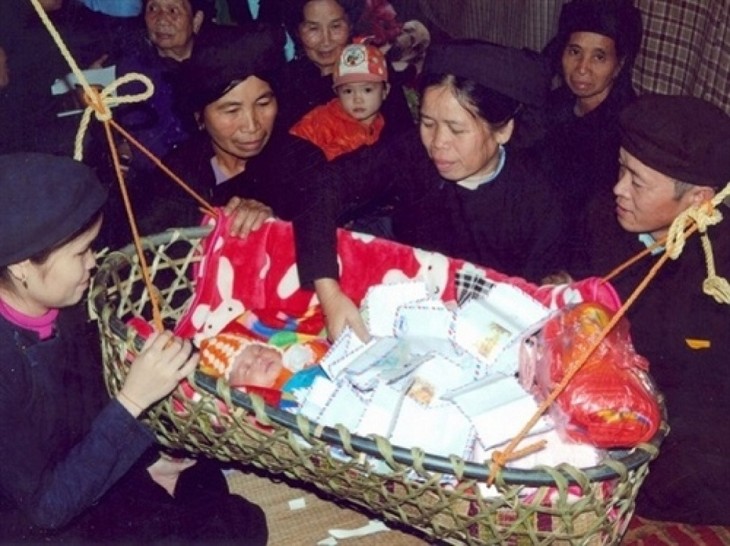(VOVWORLD) - The Tay ethnic minority people live mainly in Vietnam’s northern mountain region and the Central Highlands. No matter where they live, the Tay practice similar customs and religious rituals, the most prominent being their full-month ceremony and their longevity ritual.
 A full-month ceremony for a Tay baby (photo: VNA) A full-month ceremony for a Tay baby (photo: VNA) |
The full-month ceremony is the first important ritual in the life of a Tay individual. It’s an important milestone – the moment when an infant is acknowledged by its ancestors and extended family.
The shaman plays an essential role in an infant’s full-month ceremony. He invites the ancestors to attend the ritual to accept a new family member. Nguyen Van Chu of Phuong Do commune, Ha Giang city, said: “The ceremony is usually held on the 33rd day after the child’s birth. We inform our ancestors that the baby is 33 days old and is officially joining the community. Part of the full-month ceremony is giving offerings to the baby’s midwives in heaven.”
The worship of the heavenly midwives is performed before the family's ancestral altar. The most important step is giving offerings to the midwives – mainly home-grown agricultural products – to thank them for protecting and blessing the baby, Nguyen Van Chu said.
“In the past the family prepared a pig, a goat, or a buffalo for the offering. Now the offering can be a chicken or a duck. We offer the midwives a shirt that belongs to the baby plus 9 flowers if it’s a girl or 7 flowers if it’s a boy. We inform them that the baby has been born and the parents will raise him or her,” Chu said.
The Tay call the place where the midwives live in heaven ‘the midwives’ door’. The shaman approaches the midwives’ door, presents the offering, and thanks the them for giving the couple a child.
Hoang Tuong Lai of Xuan Lai commune, Yan Bai province, says that after a ceremony to name the baby, the shaman performs a ritual to accept the baby as a new family member and then takes the baby to the market. During the ceremony, the maternal grandmother gives the child a papoose, according to Lai.
“On the day of welcoming her daughter-in-law, the mother-in-law saves a piece of fabric to make a papoose for her grandchild. The shaman casts a spell on the papoose to ensure that the baby will always be safe and healthy on the back of his or her mother, sister, or father.”
The longevity ceremony is another important ritual in the life of the Tay. It shows the children’s filial piety and respect for their grandparents and parents and prays for their health and longevity. The ceremony begins in the evening and continues until the next morning. The family places three offering trays in front of the altar, including a tray of vegetarian food for the midwives and two trays for ancestors and deities.
Mr. Nguyen Van Chu explains: “Tay people up to 61 years old can organize a longevity ceremony. The family prepares a pig – big or small depending on their financial conditions – plus 9 pounded-rice cakes (banh giay) for a woman or 7 cakes for a man. Sometimes they prepare just a pig head and 4 legs. At a longevity ceremony for a 70-year-old man or woman, the family organizes a party where relatives and friends can congratulate the honoree.”
The relatives bring small bags of rice, and after the ritual, they pour this rice into a basket, which is then covered with a black cloth and topped with votive papers and amulets, symbolizing a bridge linking heaven and earth. The longevity ceremony of the Tay is an expression of filial piety and gratitude to parents and grandparents.